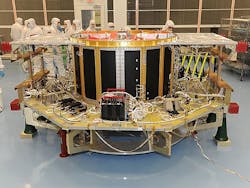Industry and government attack costs and promote reuse in space electronics with VITA 78
The initiative, backed by the VITA Open Standards and Open Markets industry trade group in Fountain Hills, Ariz., is called SpaceVPX, or VITA 78. It's an attempt to create standard interfaces, data paths, connectors, and other building blocks for space electronics, which historically have been custom legacy designs that are difficult and expensive to replicate and upgrade.
Legacy space systems often are point solutions with proprietary and application-specific internal interfaces, where re-use is not a priority, explains Patrick Collier, senior electrical research engineer and deputy program manager at the Air Force Research Laboratory at Kirtland Air Force Base, N.M.
Today's legacy space electronic designs typically use modules that are not designed to interoperate either at the hardware of software level, Collier says. He made his comments last month at the VITA Embedded Tech Trends conference in Phoenix.
One of the biggest problems with today's legacy space electronics designs is the prime contractor has a central role for the life of the system, which limits flexibility and options, and stifles competition, Collier says.
Related: Rad-hard space electronics hit the mainstream
VITA 78 SpaceVPX, instead, seeks to use open-systems architecture guidelines and open standards to achieve loose coupling between software and hardware in space electronics designs.
"It’s the customers that want this," Collier told Embedded Tech Trends attendees last month in Phoenix. "They are driving this to industry, and industry is going to want to adopt this to deliver what the customers want."
SpaceVPX is intended to reduce risks and costs tied to reintegration of interfaces to make software and hardware reuse more attractive and affordable. Use of industry-consensus interfaces will provide more vendor based options from a broader market, with more regular sustained competition, he says.
VITA 78 SpaceVPX is related to the OpenVPX embedded computing industry standards, but considers the special needs of space like radiation hardness, extreme reliability, and the ability to operate for prolonged periods in harsh operating conditions not found on land, sea, or in the air.
The standard defines payload, switch, controller, and backplane module profiles to meet the needs of space applications, and adds features to the utility plane for fault tolerance. Space VPX calls out point-to-point data paths, not bused paths, to help space systems tolerate faults and avoid module failures that affect the entire system.
SpaceVPX adds a space utility module to provide a dual-redundant source for utility plane implementations, and defines use of the IEEE 1355-based SpaceWire spacecraft communications network standard for control plane over Ethernet.
The SpaceVPX standard seeks to maintain reasonable compatibility with OpenVPX components such as connector pin assignments to help promote interoperability and vendor choice in space electronic designs, speed development and deployment time, offer relatively high board volumes for economies of scale, and encourage a high velocity of space technology upgrades, Collier says.
As far as industry acceptance of VITA 78 SpaceVPX is concerned, the standard was approved by the VITA Standards Organization last December, and several vendors are adopting the standard, Collier says. NASA is evaluating 6U and 3U SpaceVPX form factors, and prototype products should be available by next fall or winter.
For more information contact the VITA Standards Organization online at www.vita.com/policies, or the Air Force Research Laboratory's Space Vehicles Directorate at www.kirtland.af.mil/afrl_vs.
